Step-by-step instructions: how to grow leek seedlings
Leeks are a valuable vegetable crop with a unique set of vitamins and minerals. The white part of the plant is highly valued in cooking, has a delicate, sweetish taste without the bitterness inherent in common onions.
The culture is grown mainly by seedlings due to the long growing season, which is about 6 months. The seedless method is used exclusively in the south of Russia due to the early spring and warm weather that lasts until mid-autumn. In this article we will show you how to grow leek seedlings, how to care for seedlings, and when to transfer them outdoors.
The content of the article
The optimal timing for planting leek seedlings
Favorable days for sowing leek differ depending on the region.... In the north of the country, sowing for seedlings is carried out from April to May. The transfer to open ground begins in June, when the ground and air warm up to a minimum temperature of + 15 ° C.
The central regions of the country are distinguished by more favorable climatic conditions, therefore sowing work begins in mid-February. Planting of mature seedlings in a greenhouse is carried out in the second decade of April, and in the open field - in the second decade of May.
In the southern regions, leeks are planted directly in the ground in late May - early June. This is facilitated by favorable climatic conditions.
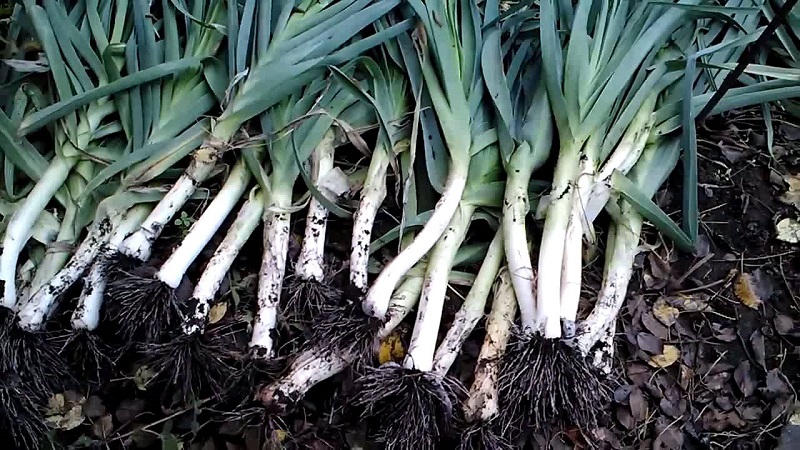
Depending on the variety
The growing season for leeks is about 6 months... Crop varieties are divided into groups depending on the ripening period:
- early (summer) - ripen in 130-150 days, harvest - from August to early September;
- mid-season (autumn) - ripen in 150-180 days, harvest - in October;
- late (winter) - ripening period is more than 180 days, harvest - in November-December.
Taking into account the information on the ripening times indicated by the seed producer on the package, gardeners determine the time of sowing leeks for seedlings. Early varieties are sown in April, mid-season ones - in late February - early March, late ones - in late January - early February.
Depending on the lunar calendar
When to plant leek seedlings? Experienced gardeners advise sowing leeks for seedlings, taking into account the phases of the moon.
Auspicious days for sowing in 2020:
- January - 1, 5-9, 11, 14, 15, 16, 21, 22, 25, 29;
- February - 2-4, 10, 13, 14, 15, 17, 18, 20, 21, 24, 28, 29;
- March - 1, 3-5, 10, 11, 14-16, 18, 19, 21, 22, 29-31;
- April - 2-4, 6, 7, 9, 10, 14, 15, 23, 25, 27-29;
- May - 2, 3, 5, 6, 9, 12-14, 20, 22, 23, 25, 27-29;
- June - 1, 2, 4, 8, 11-13, 18, 19, 22, 24, 26-29.
Sowing technology of leeks for seedlings
The technology of sowing crops for seedlings allows you to get strong and healthy seedlings, to collect a large harvest. Seeds are disinfected and soaked in order to increase germination... Sow in common boxes or individual containers. Standard care - watering, picking, feeding, hardening.
Seed preparation
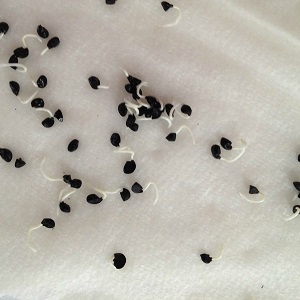 To increase germination, the seed is soaked in water room temperature for 24 hours, and then dry in the open air.
To increase germination, the seed is soaked in water room temperature for 24 hours, and then dry in the open air.
The second method of pre-sowing treatment is soaking in a thermos in water with a temperature of + 40 ° С for 3-5 hours. Then the seeds are washed in cold water and dried.
To disinfect the material, use strong solution of potassium permanganate or "Fitosporin".
Reference. The optimum shelf life of seeds with retention of germination is 3 years.
Soil and tank preparation
Light but nutritious soil is ideal for fast sprouting of leeks... Heavy, clayey soil is not used for this purpose.
In shops for gardeners there is a ready-made substrate for growing seedlings of peppers, cucumbers, eggplants, enriched with essential nutrients. It is also suitable for growing leeks.
For self-preparation of the soil mixture in a large bucket, mix:
- peat, garden soil, humus (1: 1: 2);
- ash, eggshells, peat, moss, sawdust, turf (in equal amounts).
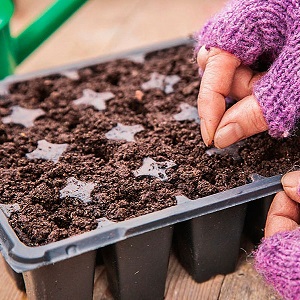 Before use, the soil is watered with a steep solution potassium permanganate or "Fitosporin". To deoxidize the soil, add 200 g of wood ash to the bucket. Alkaline soil is normalized with dolomite flour.
Before use, the soil is watered with a steep solution potassium permanganate or "Fitosporin". To deoxidize the soil, add 200 g of wood ash to the bucket. Alkaline soil is normalized with dolomite flour.
To increase soil nutrition use urea, potassium salt, compost, superphosphate.
Containers for growing leek seedlings are suitable for any: tetrapacks, trays, boxes, pots, glasses. The container is poured over with boiling water or hot potassium permanganate solution.
Peat tablets are a great alternative to plastic boxes... Their use greatly simplifies the process of sowing seeds - no need to prepare a soil mixture. The tablets are required to maintain a constant moisture level due to rapid drying. This is perhaps their only drawback.
Interesting on the site:
Sowing technology
Seed sowing technology depends on the container used:
- when sowing in individual cups, 3-4 seeds are placed in the ground to a depth of 1 cm;
- 1 seed is sown into common containers in furrows 1-1.5 cm deep at a distance of 4-5 cm;
- sowing in a snail provides for laying out seeds every 5 cm, with an indent from the edge of 2-3 cm.
The container is filled with wet soil and the seeds are sealed... A 5 mm layer of sand or peat is poured on top and poured with water through a sieve.
The containers are covered with plastic wrap or glass. Leave the future seedlings in a warm place at a temperature of + 21 ... + 25 ° C until shoots appear.
Sowing in a snail
Sowing seeds in a snail gives strong and healthy seedlings and saves window sill area.

To twist the snail use:
- lining for laminate or dense polyethylene 10 cm wide;
- ready-made substrate;
- elastic band;
- a pallet that is larger than the rolled roll.
Sowing rules:
- spread the strip on a table or floor, sprinkle in damp soil;
- retreat 2 cm from the edge of the tape and lay out the seeds, slightly dipping into the ground, with an interval of 4 cm;
- roll up the tape and secure with rubber bands;
- put the snail in the pallet with the seeds up;
- moisten the soil with a spray bottle and close it with a plastic bag;
- as soon as shoots appear, remove the package and move the tray with the snail to the lighted windowsill.
Seedling care is the same as caring for seedlings in boxes or glasses... The main difference is that water is poured into a sump, and not poured from above.
Features of growing seedlings
When growing leek seedlings, observe: the mode of watering, feeding, maintain the optimal temperature and the norm of daylight hours. Seedlings dive from common boxes into individual glasses and harden them a week before transferring to open ground.
Watering mode
Leeks need frequent and abundant watering - 2-3 times a week... Young stems are too thin and weak, so watering is done carefully through a sieve or syringe under the root.
Spraying with a spray bottle moisturizes the stems and washes away dust.
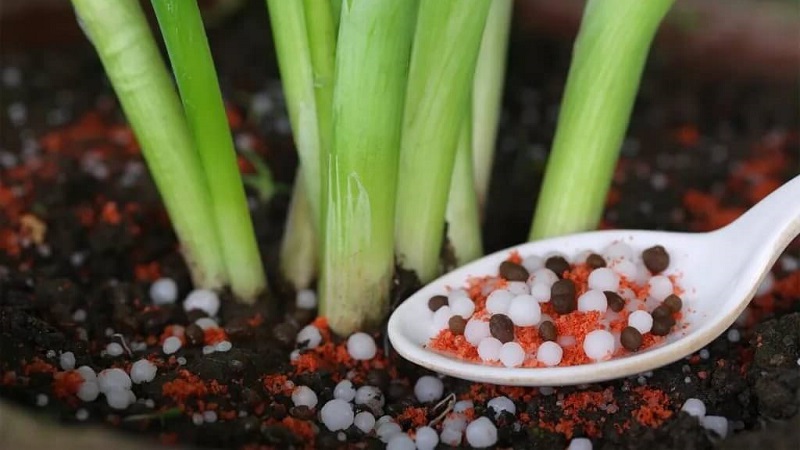
Top dressing
During growth seedlings are fed twice:
- two weeks after germination;
- a week before transferring to an open area.
Used as fertilizers ready-made composition "Kemira-universal" or mix the components independently - dissolve 5 g of potassium chloride, 20 g of superphosphate and 10 g of urea in 5 liters of water.
The best food for leeks is bird droppings.... For its preparation, 500 g of droppings are diluted in 10 liters of water and carefully watered the seedlings under the root, trying not to get on the stems.
Temperature regime and illumination
After the emergence of friendly shoots - this happens after 2-3 weeks - the containers are transferred to a cool place with an air temperature of + 10 ... + 12 ° С at night, + 15 ... + 17 ° С during the day. In such conditions, the seedlings are kept for a week. Then the air temperature is increased to + 13 ... + 15 ° С at night, + 18 ... + 20 ° С. In this mode, the seedlings are kept until their final transplantation into open ground.
Optimal daylight hours - 12 hours... With early sowing in late January - early February, it becomes necessary to supplement the seedlings with a phytolamp, the budget option is LED lamps.
Pick and trim leaves
 When sowing seeds in a common container, a mandatory pick is carried out in separate containers. The strongest seedlings are chosen, gently poured in with a spoon and planted in a prepared container with moist soil.
When sowing seeds in a common container, a mandatory pick is carried out in separate containers. The strongest seedlings are chosen, gently poured in with a spoon and planted in a prepared container with moist soil.
To form the correct bulb earth is periodically poured into the container.
For the seedlings to grow strong, pruning the stems every 14 days, keeping the height at 10 cm. This ensures proper root development and thickening of the stem.
Reference. After 30 days, seedlings in common containers are thinned out, leaving a distance of 3-4 cm between them.
Hardening
A week before planting in the beds, the seedlings are taken out into the street for hardening... The containers are left in partial shade. The time is gradually increased, starting from 30 minutes and ending at 12-16 hours.
Read also:
Features of planting in open ground
About seven weeks after the appearance of the third leaf, the seedlings are planted in the garden. Before transplanting, the root and leaves are pinched by a third to obtain better quality greens and accelerate rooting.
The term for transferring seedlings to a permanent place occurs in the period from 55 to 65 days after germination.
Leek cultivation plot is prepared in autumn or spring.: carry out deep plowing of the earth, bring in humus, make markings.
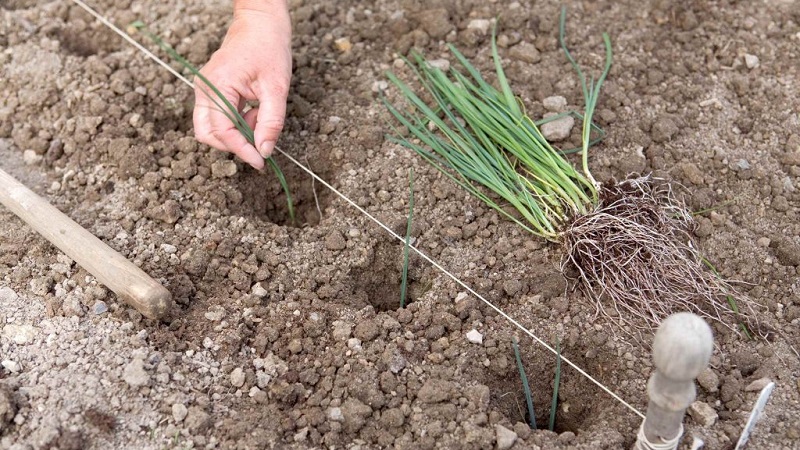
Onions prefer soil with neutral or slightly alkaline acidity... The optimum acidity is 6.4-7.9. To normalize the pH, dolomite flour or limestone is added in an amount of 400-500 g per sq. m.
Advice! Plant leeks next to carrots, strawberries, and beets. Follow the rule of crop rotation - grow the crop after beans, peas, tomatoes, potatoes, cabbage.
Leek it is not recommended to plant in the same place more often than once every three years.
For better survival the roots of the plant are dipped in a mash made of clay and mullein, mixed 1: 1.
Seedlings are planted in ditches 10-13 cm deep with an interval of 15-20 cm... The row spacing is 35-45 cm. This is the ideal planting pattern, allowing easy access to the plants.
A mixture of 0.5 liters of wood ash and 10 liters of humus is poured into the ditches.
Planting care
Leek care rules:
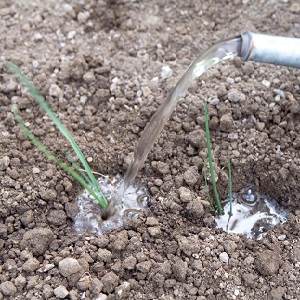 Water the onion every 4-5 days... In drought, the amount of watering is increased. For this, both warm and cold settled water in an amount of 10 liters per sq. m. It is important to maintain constant soil moisture, avoiding drying out and stagnant water in the beds. At the beginning of the growing season in open ground, the soil is abundantly shed with water to a depth of 7-10 cm.
Water the onion every 4-5 days... In drought, the amount of watering is increased. For this, both warm and cold settled water in an amount of 10 liters per sq. m. It is important to maintain constant soil moisture, avoiding drying out and stagnant water in the beds. At the beginning of the growing season in open ground, the soil is abundantly shed with water to a depth of 7-10 cm.- Hilling stems carried out when the seedlings take root in a new place (40-60 days after planting) and the stems reach a thickness of 5-7 mm. This helps whiten the stems, making them taste tender and sweet. The procedure is carried out every two weeks, at least four times per season.
- Loosening is carried out after each watering, weeding - as needed.
- Soil mulching sawdust, hay or straw reduces the amount of weeding and loosening.
- Leek feeding is carried out a solution of chicken manure with the addition of phosphorus and potassium: 1 part of the manure is mixed with 20 parts of water, 35 parts of superphosphate or nitrophosphate.
- Treatment from diseases and pests carried out without fail to maintain plant health and harvest a rich harvest at the end of the season.
Protection against diseases and pests
Viral mosaic poses the greatest threat to leeks... This insidious disease does not manifest itself in any way during the period of growing seedlings and is not cured by anything. The main carrier of the virus is the melon aphid. Symptoms of the disease appear after the onion is planted in the ground. Longitudinal yellow spots appear on the stems, the plant lags behind in development and begins to turn yellow and dry.

Viral diseases are fought with the help of agricultural technology:
- weed cleaning;
- destruction of insects;
- crop rotation;
- selection of virus-resistant varieties;
- seed dressing before sowing;
- cleaning from the site of infected plants from the garden.
Leek is susceptible to fungal diseases.: rust (bright yellow pads of fungal spores on the leaves) and downy mildew (death of feather tips, whitish or pale gray greens). To combat fungal infections, a solution of copper oxychloride (40 g / 10 l) and "Fitosporin" (5 g / 10 l).
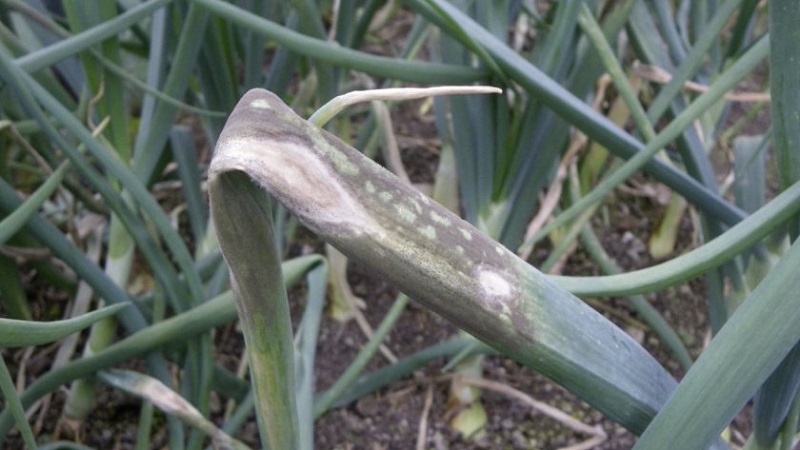
Among insects, the main danger for leeks is onion fly... The pest has an exorbitant appetite and is able to deprive the gardener of most of the harvest.
The fly lays its eggs on leaves and in the ground in mid-May. After 3-4 days, larvae appear, feeding on the central part of the onion. The plant withers quickly and rots completely.
To protect the plantings, the beds are pollinated:
- wood ash - 200 g per sq. m;
- pure tobacco dust or a mixture of tobacco and ash in a 1: 1 ratio;
- ground red pepper — 1 tsp. per sq. m.
After treatments, the soil is thoroughly loosened.
In the fight against onion fly, tobacco infusion has proven itself well: 200 g of makhorka per 10 liters of boiling water. The mixture is infused for 12 hours and 25 g of liquid soap is added. The infusion is used for spraying plants.
Conclusion
Growing leeks through seedlings allows you to harvest a rich harvest on time. The culture has a long growth period - from 130 to 180 days or more, depending on the variety. When choosing a sowing date, gardeners are guided by the lunar calendar and the climatic features of the growing region. Sowing work begins at the end of January in regions with risky farming (Siberia) and ends in May in the southern regions. In the regions of the middle lane, sowing is carried out in March - April.
Crop care provides for abundant watering, hilling, loosening, weeding, feeding with organic matter and minerals, and protection from diseases and pests.